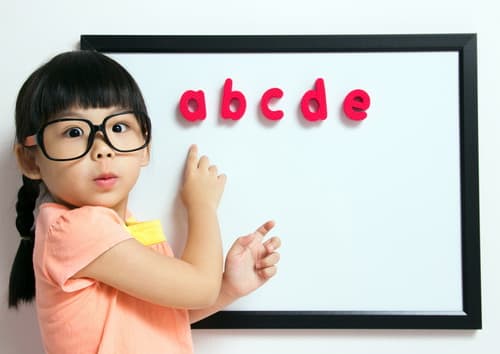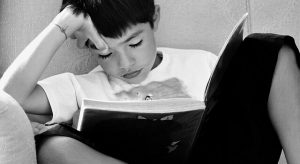Dyslexia is a complex condition that affects the way the brain processes and interprets information. Dyslexia can impact reading, writing, and spelling skills.
Dyslexia can also cause difficulty with organizational skills, concentration in noisy environments, planning, and prioritizing. Children with dyslexia experience many academic challenges due to the disorders’ many effects. In order to properly diagnose and treat dyslexia, a multidisciplinary approach is necessary.
It is important to understand that dyslexia is not associated with a low IQ —Albert Einstein was dyslexic and had an estimated IQ of 160! However, many times, children may fall prey to negative stigmas with specific regards to their learning abilities, resulting in low self esteem and self worth as a student.
Proper treatment, typically involving vision therapy, can improve the visual skills necessary for academic success.
How does dyslexia affect children?
According to the American Optometric Association, 25 percent of all children have a vision problem significant enough to impact their learning— indicating that 1 in 4 students have a vision-based learning disability.
Dyslexia is one of the most common learning disabilities. Research indicates that up to 15 percent of the population may be dyslexic, and that fewer than 1 in 10 will actually receive a formal diagnosis.
Since up to 80 percent of learning in school is acquired through vision, a child with dyslexia will have difficulty with academic performance. Children with dyslexia usually present with learning difficulties in the early years of their formal schooling.
What are the signs of dyslexia?
A student that has difficulty reciting the sounds of the alphabet, spelling words, copying words from the board, reading, and writing, is showing signs of dyslexia. Below is a list of the common ‘red flags’, that children with dyslexia usually have trouble with:
- Phonological awareness. The ability to understand sounds and how they can change the meaning of words. For example, understanding that if you change the c in ‘cat’ to a m, the word becomes ‘mat’.
- Verbal memory. The ability to recall verbal information after a short amount of time. For example, copying notes from the board.
- Verbal processing speed. The speed at which you can process and recognize familiar verbal information. For example, how fast you can write down a phone number after it is given to you verbally.
What are the symptoms of dyslexia?
Difficulties resulting from dyslexia can be broken down according to age, with symptoms ranging from mild to severe:
Under age 5
- Recognizing the alphabet letters or sounds
- Mixing up letters when pronouncing a word (saying ‘hat’ instead of ‘bat’)
- Learning new vocabulary
- Learning common word sequences (days of the week or months of the year)
Ages 5-13
- Reversing words when reading (‘saw’ and ‘was’)
- Confusing similar shaped letters, such as b, d, p and q
- Backwards writing numbers, such as 2 and 5 and 6 and 9
- Understanding math word problems
- Recalling facts or numbers
- Understanding spelling rules
- Following directions in order
- Understanding new information
Ages 13 and above
- Time management
- Understanding jokes or idioms
- Reading aloud
- Reading below grade level
- Learning a new language
- Retelling main ideas of a story
- Comprehension
Contact a vision therapy doctor near you to start a vision therapy program to help improve your vision.
SEE RELATED: Dyslexia FAQs
How does dyslexia affect adults?
According to recent data, it is estimated that 1 in 10 adults have dyslexia. In other words, up to 20 million American adults could be dyslexic.
It is important to understand that children who suffer from dyslexia will continue to suffer into their adulthood, if never given the proper tools or treatments to reduce the effects of this condition. However, improvement of reading, spelling, and writing skills is still possible even as an adult.
Could dyslexia be a vision problem?
The symptoms of dyslexia are often similar to those experienced with vision problems. For this reason, an eye exam is essential if you feel your child has dyslexia.
With a comprehensive eye exam, your doctor will be able to identify signs of vision problems, even before formal schooling begins, and before difficulties in reading, spelling, and writing start.
Healthy vision is an important component in the learning process. To detect learning-related vision problems, each of the following visual functions must be carefully evaluated:
- Visual pathway integrity- ocular health, visual acuity and refractive status
- Visual efficiency– accommodation (focusing), binocular vision (eye teaming) and eye movements
- Visual information processing -identification and discrimination, spatial awareness, and integration with other senses.
What are the signs and symptoms of vision problems?
- Eye strain or headaches
- Double vision or blurred vision
- Crossed eyes (strabismus)
- Excessive blinking while reading
- Avoidance of reading or writing
- Reduced concentration during visual tasks
- Poor reading fluency or comprehension
- Poor short term or long term visual memory
- Consistent reversal of words or letters (that continues after second grade)
Vision therapy for dyslexia
Vision therapy aimed at the improvement of the child’s visual efficiency and processing, is a highly effective treatment for dyslexia. Vision therapy may involve the use of lenses or prisms to help train visual skills. In some cases, doctors may recommend that children wear eyeglasses full time, or as needed for activities such as reading.
Dyslexia requires a multidisciplinary approach
A comprehensive eye exam is a critical component of a multi-disciplinary approach in the diagnosis and treatment of dyslexia.
With a comprehensive assessment of your child’s visual skills , your eye doctor will be able to identify signs of dyslexia— most commonly, binocular vision problems such as focusing difficulties and eye teaming and coordination problems.
During your child’s eye exam, it is important to inform your doctor of any family history of dyslexia, and any difficulties your child may have with oral language, namely: vocabulary retrieval, structuring appropriate sentences, or recognizing/manipulating sounds within words.
The earlier the diagnosis is confirmed, the earlier the child can begin to receive appropriate treatment.
LEARN MORE: Vision for School
If your child is showing signs of learning difficulties, as well as symptoms related to dyslexia, he may present with a vision-related learning disorder. Schedule an eye exam to take the first step in improving your child’s visual skills and reducing the effects associated with dyslexia.










